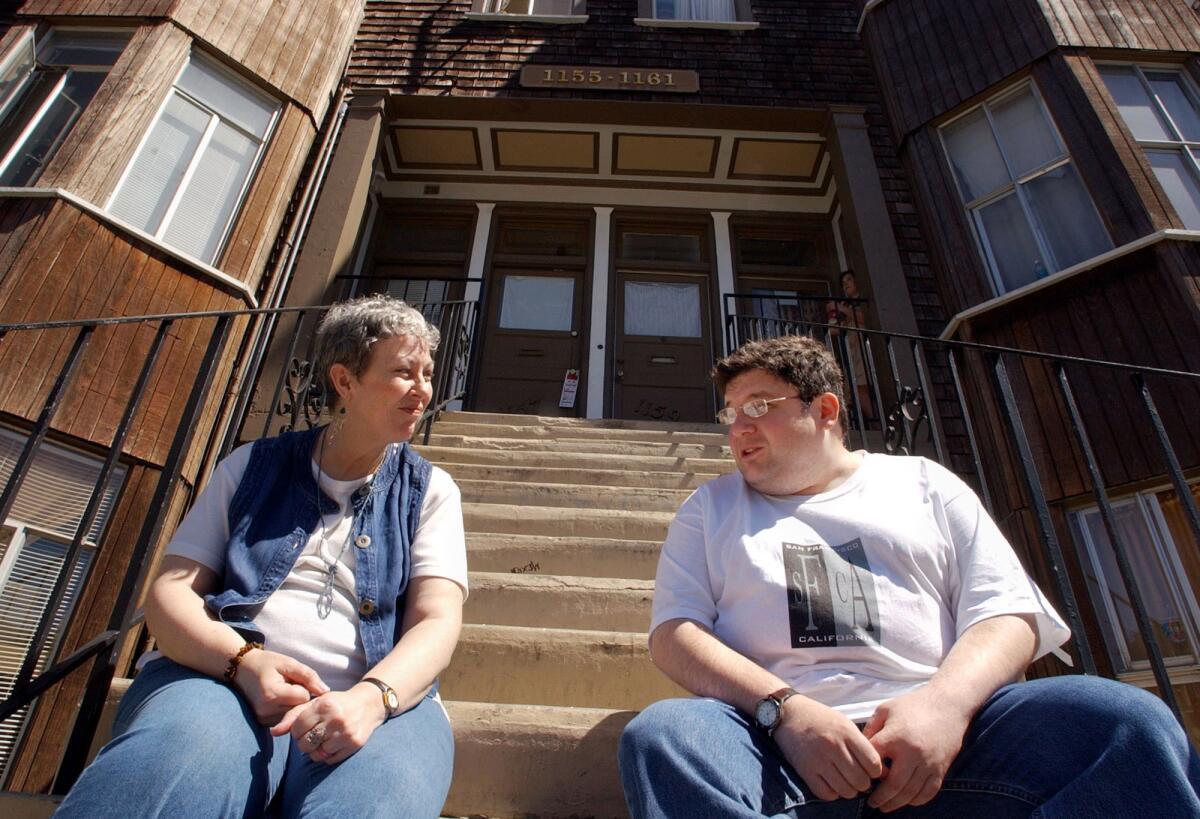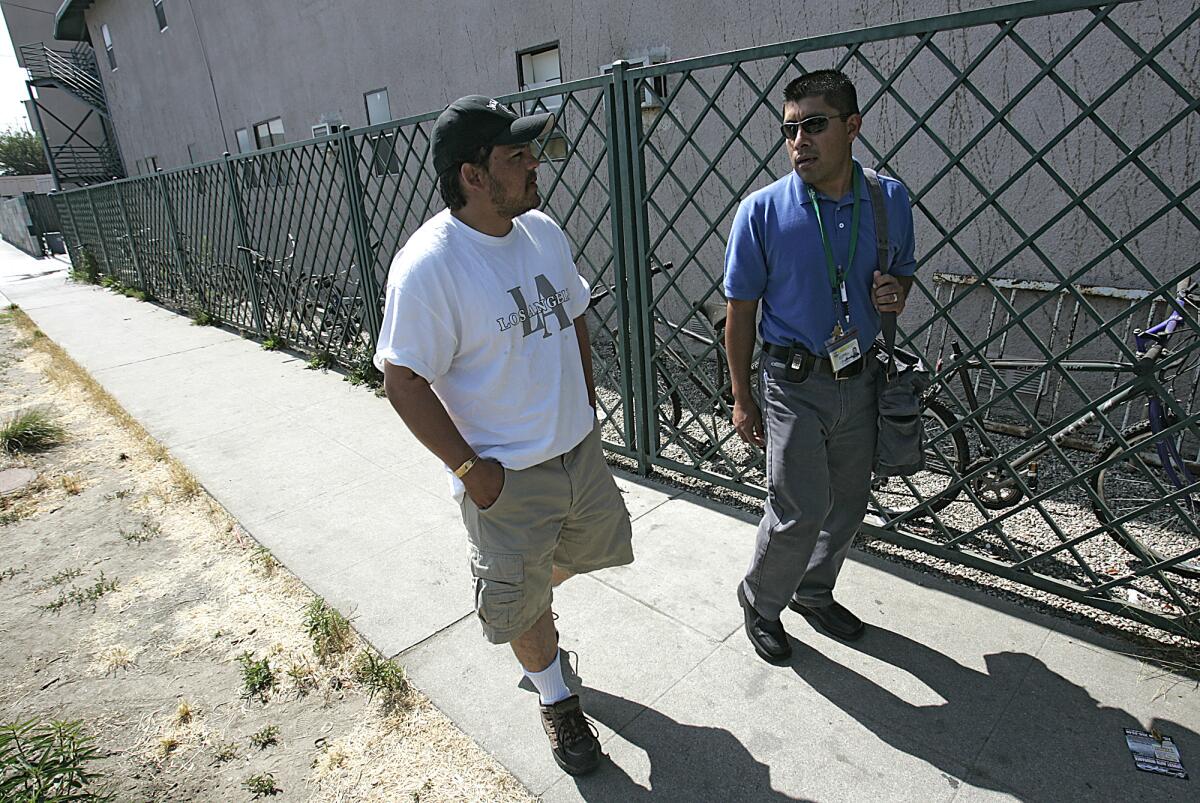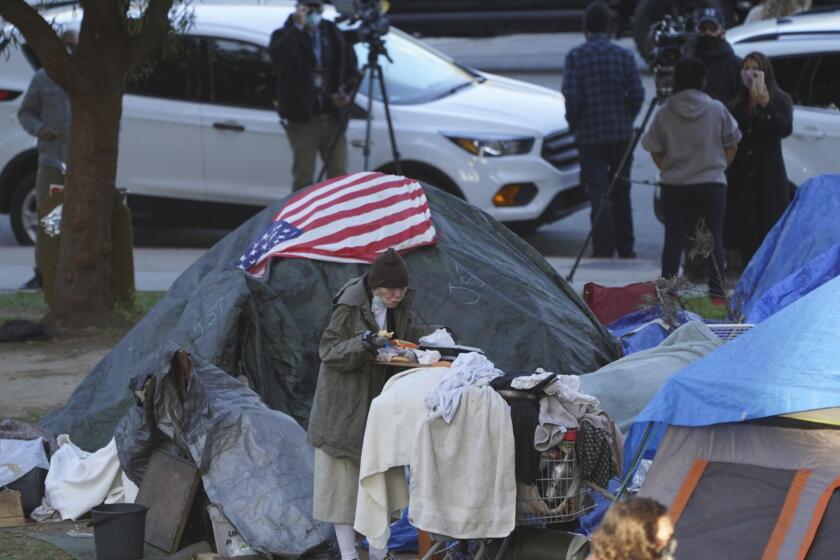California taxed millionaires to fix its mental health crisis. Why itâs fallen so short

SACRAMENTO â Nearly two decades ago, California voters passed a landmark tax on millionaires envisioned as a game changer for mental health.
Supporters promised the new money would drastically reduce homelessness and improve access to services for all Californians.
âNo one who is mentally ill and now on the street will be on the street in five years,â promised the late Rusty Selix, who was executive director of the Mental Health Assn. of California and a co-author of the ballot initiative, Proposition 63. âThat doesnât mean there wonât be homeless. But you will see a measurable decline.â
Since voters approved the tax in 2004, it has generated an escalating gusher of money â $29 billion in total, half of which has come in just the last five years.

Those funds have boosted early intervention programs in schools and communities, created wraparound services for severely mentally disabled homeless people and enhanced community outreach. Backers say the money has drastically improved life for hundreds of thousands of Californians.
But amid a steadily worsening homeless crisis, itâs clear the results have fallen far short of the initial promise.
A Los Angeles Times review points to several major, overlapping reasons, including chronic and systemic underfunding of other social and mental health programs, unpredictable swings in revenue, bureaucratic infighting between state and county officials and, in the last few years, a severe shortage of mental health clinicians.
With Proposition 63 expected to put an additional $3.8 billion into mental health services this fiscal year, some advocates say itâs time that California takes another look at how the money is being spent.
The recession effect
Alex Briscoeâs experience during the Great Recession illustrates part of what has gone wrong.
As the health director for Alameda County, Briscoe stared in horror in 2009 as recession-driven cutbacks carved holes in his $600-million budget. He tried to figure out how he would pay for things such as partial hospitalization programs for people in a psychiatric crisis, homeless outreach and salaries for essential employees.
There was only one solution he could see â an answer he embraced even though it was not perfectly within the letter of the law.

He would game the system by taking funds from the Mental Health Services Act, the money generated by Proposition 63. The act didnât allow using the money to fund existing programs; it was meant for new or enhanced services. But Briscoe saw a loophole â the rules allowed counties to âredesignâ programs.
âI was faced with harsh realities,â Briscoe explained. âDo I cut? Or do I âquoteâ redesign and rebrand [existing programs] to fund themâ and avoid mass layoffs?
When California voters passed a tax on high-income residents in 2004, backers said it would make good on the stateâs âfailed promiseâ to help counties pay for the treatment of the mentally ill.
Briscoe, who left Alameda County in 2016 and now works as principal of the California Childrenâs Trust, said he knew he could âget in troubleâ for admitting this, but he felt there was little choice.
Many mental health leaders in the stateâs 58 counties soon came to the same conclusion.
The recession that began in 2008 decimated public coffers. Public employees were laid off and furloughed, public services of all kinds were cut or curtailed.
Then, in 2011, the state shifted nearly $900 million of Proposition 63 money to temporarily cover mental health programs typically paid for by the general fund and eased state oversight of countiesâ spending. Darrell Steinberg, the co-author of the proposition and a state senator at the time, voted to allow it.
Using the money for existing programs wasnât the intent of the act, but âwhat do you do when the underlying mental health budgets are being cut everywhere else?â said Steinberg, who is now the mayor of Sacramento.
âThe answer is, you help as many people as you can,â he said. âWhere it has patched holes, it has also saved lives.â
The economy eventually improved but not on the streets, where many mentally ill people wound up, caught in a housing affordability crisis that grew only more dire and an opioid crisis that exploded. That was followed by a meth crisis and a fentanyl crisis, which pushed more people onto the streets and stretched substance abuse and mental health programs to a breaking point.
Meanwhile, many county officials complain that mental health budgets are habitually underfunded, forcing them to rely on Proposition 63 money to fill the gaps.
The funding was never supposed to plug holes, said Michelle Doty Cabrera, executive director of the County Behavioral Health Directors Assn., âbut I donât know what we would do without it.â

Unspent funds?
The diversion of funds provides one reason Proposition 63 hasnât fully lived up to its promise. Another is a bureaucratic morass that leaves the public, and even state and local officials, unsure how much money is available and how itâs spent.
The Mental Health Services Act levies a tax of 1% on incomes above $1 million. That money flows from the state to counties for use in five areas â community support, prevention, innovation, facilities and workforce training.
State officials have accused counties of hoarding vast piles of cash that could â and they argue should â be spent more quickly on services. Counties insist Californiaâs system for tracking their spending relies on delayed data that creates an illusion of surplus where none exists.
The Steinberg Institute, a public policy nonprofit that Steinberg founded, said state data show counties are currently stockpiling about $2 billion and that Los Angeles County alone had nearly $1 billion it had not spent as of this spring.
Los Angeles County officials said their state counterparts are routinely mistaken and called their accounting âa puzzle.â Not only are they not sitting on money, they said, they are actually at risk of dipping into their reserves.
State and local disputes over whether counties are stockpiling cash or spending every dollar have persisted for years â often with little financial consequence.
California officials have the power to ârevertâ county funds back to state coffers if they are not spent in a timely fashion, but they rarely claw back huge sums.
In part, county officials said, that is because they often can convince state officials that the local government accounting is more accurate.
âThis funding stream is so complex and so complicated, it just looks like counties are sitting on money,â said Scott Kennelly, director of behavioral health for Butte County.
If anyone should have been able to escape homelessness, itâs John Maurer, whose siblings are prominent in L.A.âs homelessness and mental health systems.
Up and down the state, county officials defend their stewardship of the money, saying they have done the best they can with available resources.
âIt is bringing amazing things to our communities,â said Ryan Quist, Sacramento Countyâs director of behavioral health. âIf we had more funding, we would do more.â
Los Angeles County got approval for mobile health vans, modeled after a program in Sweden, that dispatch therapists and nurses instead of police to help people in the street.
Orange County created centers that make it possible for people to access services from different agencies and networks all in one place.
San Bernardino County launched a program to send therapists to treat people in the streets, rather than forcing homeless people to come into clinics.
And from Humboldt to Solano to San Diego, the government has launched programs to reach the stateâs widely diverse populations â tribal programs in the north, Hmong programs in the Central Valley, and Filipino- and Spanish-language programs statewide.
As imperfect as the system is, Steinberg said, the situation would be far worse without it. âWe now have billions of dollars that have been put to use to help hundreds of thousands of people.â
Paul Stansbury, who lives in the South Bay, would concur in part. For decades, he has sought to care for his 43-year-old son, who suffers from schizoaffective disorder and drug and alcohol addiction. His son has benefited from programs created by Proposition 63, he said, including one in which a social worker, a psychiatrist and a medical doctor coordinated his care.
But his son, whom he declined to name to protect his privacy, has also at times resisted treatment and for a period was homeless. Like many families of people living with mental disorders, Stansbury has experienced the frustrations of working through a system that is sometimes bafflingly complex.
âThe people have all been well intended and helpful, but trying to navigate the system and make it work feels like it creates these barriers,â he said.
Amidst a deepening crisis in which growing numbers of mentally ill and drug-addicted people in street encampments have become a fixture in almost every city in the state, some critics have called the entire approach a failure.
âThings have not gotten better since this ballot measure passed, they have gotten much worse,â said former Assemblyman Mike Gatto, a Democrat from Los Angeles.
âProp. 63 and the entire system has failed,â he added, and it is time for âa bold reimagining of how we spend money meant for mental health.â
Staffing shortages
Staffing for mental health services in California, already strained by funding challenges and bureaucratic complications, was delivered a body blow by the COVID-19 pandemic.
Anticipating steep cuts in revenue as the pandemic began, many counties froze hiring.
By the time county officials realized state predictions were wrong â Proposition 63 funds actually rose as many rich people saw their incomes go up in the last couple of years â not only had they not hired to keep pace, but many staff had quit. They were fearful of exposure to the coronavirus, burned out or lured away by an expansion of telehealth.
âOur workforce was decimated,â said Dr. Veronica Kelley, chief of mental health and recovery services for Orange Countyâs Health Care Agency. âMany of our colleagues are being whisked away to other providers where they can work from home in their pajamas and see the worried well on their computer screens.â
Community clinics, which provide care to poor and uninsured patients, have struggled to hire and hang onto workers as the pandemic has dragged on.
At one Los Angeles County mental health clinic, where staff members asked not to be named for fear of retaliation, a clinician said the wait time for therapy is now six months. The earliest appointment to meet with a psychiatrist for an initial medication evaluation is spring 2023.
Another longtime clinician at the same clinic said her caseload is now more than 150.
âWe are just told we have to continue to take the clients, even though we donât have the ability to provide them with consistent mental health treatment,â she said.
At a public mental health clinic in the San Fernando Valley, more than 20 staff members have left since the start of the pandemic, according to a clinician who has worked there for nearly a decade.
Clients used to be able to meet with a psychiatrist for a medication evaluation within a week. Now, the earliest appointment for an evaluation is in the fall.
Lisa Wong, acting director of the Los Angeles County Department of Mental Health, said such extreme wait times were not the norm throughout the county but did exist in certain clinics. She said staffing shortages are to blame.
At a hiring fair last year, Wong said she had 83 positions to fill. There were 13 candidates from across the county.
âWe were a system bursting at the seams before, and then you have added the pandemic to it,â Wong said. âOn one hand, we have an overburdened system, we have staffing shortages, increased demands, all those things. And on the other hand, we have a perception by many people that we have a lot of dollars to spend and a lot of dollars on the table.â
Gathering crisis
State lawmakers and many local leaders have known about Proposition 63âs shortcomings for years but have taken little action to solve them.
But this time may be different.
Homeless encampments â and the dire and visible needs of the increasing numbers of people who live in them â have become among the stateâs most potent social and political problems.
They are a central issue in the Los Angeles mayorâs race and featured in elections from Shasta County to the recall of San Francisco Dist. Atty. Chesa Boudin.
After announcing the broad framework of his CARE Court plan, the real work begins for Gov. Gavin Newsom.
State leaders have vowed to act, with Gov. Gavin Newsom proposing a new program called CARE Court â short for the Community Assistance, Recovery and Empowerment Court â which would provide court-ordered treatment for homeless individuals with severe mental illness.
Newsomâs proposal has come under fire from disability advocates, who charge it would violate privacy rights by arbitrarily forcing people into treatment. And that is not the only reason CARE Court is controversial.
Supporters have eyed paying for the new program partially with Proposition 63 funding, a suggestion stemming from the stateâs insistence that counties have unspent money.
Under the current system, Newsom said in his 2020 State of the State speech, âresources too often donât reach the people who need it the most.â
County officials vehemently disagree and warn of dire cuts in services if they are forced to pay for CARE Court on top of other programs.
Wong, of Los Angeles County, likened Newsonâs proposal â and the idea that counties have extra money to implement it â to the old folk tale about making soup from a stone.
âWeâre going to try our best to meet the obligations, but to be realistic, we need more resources to do it,â she said.
Proposition 63 may have fallen short of its promise to transform Californiaâs mental health system, but that doesnât make it a failure, said Briscoe, the former Alameda County health director.
âTo tax millionaires to support the mental health system, what an extraordinary thing we did,â he said. âBut you canât patch 40 years of bad policy with a single progressive action.â
This article is part of The Timesâ mental health initiative, For Your Mind, an effort to increase coverage of treatment, public policy, wellness and culture related to mental health in Californiaâs communities.
More to Read
Sign up for Essential California
The most important California stories and recommendations in your inbox every morning.
You may occasionally receive promotional content from the Los Angeles Times.

















